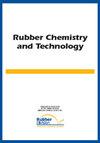GLYCIDYL METHACRYLATE AS A NON-SILANE MODIFIER IN RUBBER/SILICA COMPOSITES
IF 1.5
4区 工程技术
Q4 POLYMER SCIENCE
引用次数: 0
Abstract
Glycidyl methacrylate (GMA) was grafted onto styrene butadiene rubber (SBR) and silica by a solution grafting process. Successful grafting onto rubber and silica was confirmed by Fourier-transform infrared (FTIR) spectrometry, with the peaks at 1149, 842, and 1729 cm−1 attributed to the C–O stretching, the epoxy group, and the C=O stretching vibration of the GMA monomer, respectively. After grafting onto the silica surface, the peak at 842 cm−1 in the spectra disappeared, confirming the grafting reaction through the epoxy group. Grafting onto SBR was also confirmed by proton nuclear magnetic resonance (1H NMR) spectroscopy, and the SBR-GMA interaction was shown using two-dimensional 1H NMR spectroscopy. The grafted products were further characterized by thermogravimetric analysis (TGA) and differencial scanning calorimetry. Grafting density and grafting weight percentage of GMA-grafted silica were calculated using TGA: 10 and 20% GMA-grafted SBR and 20% GMA-grafted silica compounds and their vulcanizates were prepared. Rubber–silica interaction through grafted GMA was shown using FTIR spectroscopy for both types of vulcanizates. Dispersion of pristine and GMA-modified silica onto the SBR matrix was quantified using scanning electron microscopy and atomic force microscopy. Mechanical and dynamic mechanical properties of these GMA-modified vulcanizates were studied and compared with those of previously reported 3-octanoylthio-1-propyltriethoxysilane–modified vulcanizates. The effect of the state of dispersion of silica onto the physico-mechanical properties of the vulcanizates was investigated. The properties of the non-silane–modified systems were comparable with, and in some cases superior to, that of the new mercapto silane-modified systems in the energy-efficient tire application.甲基丙烯酸缩水甘油酯在橡胶/二氧化硅复合材料中的非硅烷改性作用
采用溶液接枝法将甲基丙烯酸缩水甘油酯(GMA)接枝到丁苯橡胶(SBR)和二氧化硅上。傅里叶变换红外光谱(FTIR)证实了GMA单体在橡胶和二氧化硅上的成功接枝,在1149、842和1729 cm−1处的峰值分别归因于C - O拉伸、环氧基团和C=O拉伸振动。接枝到二氧化硅表面后,光谱中842 cm−1处的峰消失,证实了通过环氧基接枝的反应。质子核磁共振(1H NMR)证实了SBR上的接枝反应,并用二维核磁共振(1H NMR)证实了SBR- gma的相互作用。接枝产物进一步通过热重分析(TGA)和差示扫描量热法进行表征。用TGA法计算了gma接枝二氧化硅的接枝密度和接枝重量百分比,分别制备了10%和20% gma接枝SBR和20% gma接枝二氧化硅化合物及其硫化胶。通过接枝GMA对两种类型的硫化胶进行了红外光谱分析。利用扫描电镜和原子力显微镜对原始二氧化硅和gma修饰二氧化硅在SBR基体上的分散进行了定量分析。研究了gma改性硫化胶的力学性能和动态力学性能,并与先前报道的3-辛烷基硫代-1-丙基三乙氧基硅烷改性硫化胶进行了比较。研究了二氧化硅的分散状态对硫化胶物理力学性能的影响。在节能轮胎的应用中,非硅烷改性体系的性能与新型硫醇硅烷改性体系相当,在某些情况下甚至优于新型硫醇硅烷改性体系。
本文章由计算机程序翻译,如有差异,请以英文原文为准。
求助全文
约1分钟内获得全文
求助全文
来源期刊

Rubber Chemistry and Technology
工程技术-高分子科学
CiteScore
3.50
自引率
20.00%
发文量
21
审稿时长
3.6 months
期刊介绍:
The scope of RC&T covers:
-Chemistry and Properties-
Mechanics-
Materials Science-
Nanocomposites-
Biotechnology-
Rubber Recycling-
Green Technology-
Characterization and Simulation.
Published continuously since 1928, the journal provides the deepest archive of published research in the field. Rubber Chemistry & Technology is read by scientists and engineers in academia, industry and government.
 求助内容:
求助内容: 应助结果提醒方式:
应助结果提醒方式:


